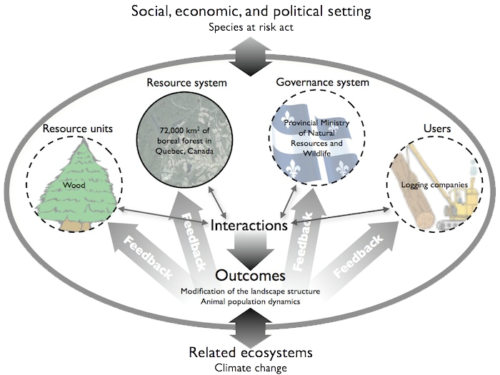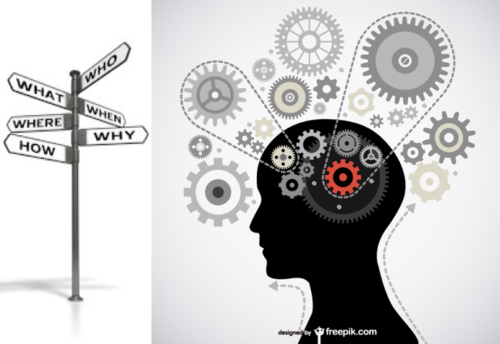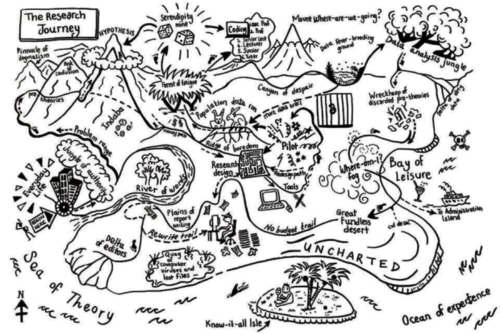Forests, floods, and fisheries… Houston, do we have a problem here?
Veronika Leitold ·Veronika Leitold
"In coupled human and natural systems, people and nature interact reciprocally and form complex feedback loops” (Liu et al., 2007). Through his comic strip of a tropical lagoon, cartoonist Jim Toomey explores many of the issues that we face daily in our world on dry land. (Source: blogs.nicholas.duke.edu)" width="500" height="438">
Last week, in our Coupled Human and Natural Systems course, we continued the presentations of our final class projects: individual research proposals to study a coupled human and natural system of our choice. The overarching theme of the presentations was natural resource use and management approached from the various angles of sustainability, stewardship and resilience. Three of the proposals focused on fisheries, which are excellent examples of integrated socio-ecological systems because the coupling is fairly evident right away: there is the natural fish stock on one side, and the people who exploit those resources on the other. In other examples, such as agro/forestry and urban development, the coupled system is composed of the natural land, forests, and waterways, which are being manipulated by humans in various ways (e.g. deforestation, carbon trading, and flood control). Thus, these systems lend themselves well to the study of the interlinked dynamics of social and environmental change.

Perhaps because we were further along in the proposal writing process by the time of the presentations, most of our talks followed the traditional structure of a written proposal, including (i) background information, (ii) research objectives, (iii) study area, (iv) methodology, (v) expected outcomes, (vi) intellectual merit and (vii) broader impacts. Nonetheless, this was another good opportunity to put our science communication skills to a test and apply the techniques of public speaking learned previously in the course. For example, a strong narrative structure emerged from Wilmelie’s talk as she described the history of artisanal fishermen in Puerto Rico and the challenges they face today. Killian opened her presentation with a series of evocative photos to tell the story of flood history in Ellicott City, demonstrating the different ways in which people have affected the river and have been affected by it. Another powerful visual was Noelle’s analogy of fishing buoys as ‘coat of arms’ which illustrated the deep-rootedness of lobstering in the Main lobster fishermen’s local culture and traditions. With the power of storytelling and use of effective visual elements, the environmental and the human aspects of the complex coupled systems appeared to have been weaved together seamlessly.![Lobster fishery is rich in history and culture. “The buoy in Maine lobster culture is the nautical equivalent of a Medieval knight's coat of arms: Each lobsterman paints his own design in his own color scheme on his buoys, effectively marking his trap territory. […] the lobsterman's buoy is an example of functional art born out of necessity but made iconic through its innate aesthetic worth.” (Source: https://visitmaine.com) Lobster fishery is rich in history and culture. “The buoy in Maine lobster culture is the nautical equivalent of a Medieval knight's coat of arms: Each lobsterman paints his own design in his own color scheme on his buoys, effectively marking his trap territory. […] the lobsterman's buoy is an example of functional art born out of necessity but made iconic through its innate aesthetic worth.” (Source: https://visitmaine.com/quarterly/lobster/lobstering-life)](/site/assets/files/2655/figure3-500x653.png)

In closing of our presentations, the class collectively reflected on the underlying themes that linked the talks together. Rachel’s insightful observation that a lot of the discussions revolved around the question of “Why are people doing what they are doing?” highlighted that motivation is a really important part of the socio-ecological systems that we study. Motivation is the driving force behind human actions – whether it is based on tradition, knowledge, values, or education, or broader socio-economic and political drivers – and knowing where agency is in the coupled human and natural system is fundamental for its thorough understanding. One has to think really carefully about what research tools to use, where to put the focus, what level of analysis is most appropriate, and when can the approach potentially run into some limitations. For example by blaming the individual agents for doing something harmful (e.g. the fishermen in Porto Rico for putting themselves in danger by diving ever deeper without appropriate gear) one might run the risk of missing the broader social, political and/or economic structures of the problem.

References:
- Liu J, Dietz T, Carpenter S R, Folke C, Alberti M, Redman C L, et al. 2007. Complexity of Coupled Human and Natural Systems. Science 317(5844):1513-1516.
- Ostrom, E. 2009. A general framework for analyzing sustainability of social-ecological systems. Science 325:419-422. http://dx.doi.org/10.1126/science.1172133
- Parrott, L., C. Chion, R. Gonzalès and G. Latombe. 2012. Agents, individuals, and networks: modeling methods to inform natural resource management in regional landscapes. Ecology and Society 17(3): 32. https://www.ecologyandsociety.org/vol17/iss3/art32/
Next Post > Chesapeake Bay report card released in Baltimore
Comments
-
Kelly H 9 years ago
Nice blog Veronika, you really brought the class full circle! I was reminded of a nice review article/section in Science Magazine recently that describes how "environmental problem" is a misnomer (http://science.sciencemag.org/content/356/6335/275). These authors discuss how so-called environmental problems are social and behavioral patterns that manifest as impacts to our ecosystems that have deleterious consequences for others (especially those with power, such as when there is property damage). The motivations for studying coupled systems really makes us challenge the perceptions of what is and isn't a "problem", in asking us to describe what that problem is and the underlying causes.
-
W.Cruz 9 years ago
Great blog! I like the ending paragraph of connecting the why with the actions. It could be the political actions brought the fisherman to the current actions. How to interconnect this actions to the current situation? Is a good approach for the proposal. In terms of the presentations I learned that if you don't understand a question say: "Can you repeat?" that instead of "I don't know" but those are part of the learning curve in class and getting nervous but now I know for the next time!!
-
Suzanne Spitzer 9 years ago
Great job pulling together some of the major themes and take-home messages from the presentations! It was interesting to hear about some of my classmates' interests, in the form of engaging stories, as you mentioned. Next time I have to write a proposal, I am going to try to make more of an effort to incorporate narrative elements. Even though we were instructed to include specific information in a specific order, it's possible to do it in a way that is more engaging and less predictable and drab than a typical proposal. Special kudos to Killian- I thought she did a particularly nice job of capturing our attention during her talk.
-
Noelle O. 9 years ago
Nice summary, Veronika! The cartoon at the beginning reminds me of the conservation biology class I took as an undergrad. My teacher described the field as a "crisis discipline" which I think aptly portrays the theme of the cartoon.
Week 2 of presentations showed that understanding the concepts behind and ways to study coupled human and natural systems is very much an ongoing learning process! I've really enjoyed seeing how people picked projects outside of their thesis research and the wide range of project topics. I agree that understanding the motivation behind what drives the human involvement in a coupled system is one of the biggest questions we are trying to answer.
-
Killian F 9 years ago
Nice blog, Veronika! To go along with people’s comments on how using narratives in your presentation can help to keep an audience hooked and make it more interesting than a formulaic proposal setup, I also think it can help the presenter. By telling more of a story with your presentation, it can help to keep a logical flow to what you are discussing, and make it easier to remember where you were going with each point.
-
Natalie Yee 9 years ago
Interesting blog! I think it summarized the presentations nicely, and I think the first graphic really drives the point home about the stress being put on aquatic management today, but there are people who want to "keep it light" when there is a serious problem at hand. I think it was interesting that many of the presenters had a questionnaire in mind to better understand the people involved. This brings out a very human dimension that makes the issue more complex. It is no longer: "The population is in danger! This needs to stop!", but rather "How are people going to be effected by the population decrease? How can there be a balance between natural and human needs?"
-
Rebecca Wenker 9 years ago
Good job, Veronika! I enjoyed your comments on the narrative structure that emerged in many of the presentations, and agree that it really helped the audience focus and become engaged in the background of the issue, the issue itself, and why/what can be done to address it. This emphasizes how a narrative method can be applied to so many things you do outside of just writing, and how it can vastly improve your communication with an audience.
Like Noelle mentioned, I also enjoyed how many of the presenters this week strayed from their research topics and approached a new problem! It was interesting to hear other issues that were of interest to my classmates, many of which I didn't know beforehand!
-
Krystal Yhap 9 years ago
Wonderful blog Veronika. I completely agree that it was easier to see the coupled part of the human and natural system people described in their presentations last week. "What is the Problem?" is a common issue I think many researchers run into. Clearly defining the boundaries for what you are specifically trying to accomplish and tackle with the study in the beginning of your proposal helps to more easily frame the rest of the proposal and why this study is important. Motivation was a huge theme linking the presentations last week, which I thought was interesting. I also really enjoyed the storytelling method many people chose to use in their presentations. It not only caught my attention but it made it easier to remember and understand the important parts of peoples proposal, the main themes, etc.It made me think back on how earlier in the semester we learned about storytelling and using narratives in science. I remember one of the articles we read talked about how a study found it was easier for people to remember narratives and they leave more of an imprint on their brain becoming a part of their memory more easily than straight facts and data and more scientific descriptions. So i agree with Suzi, I hope to use a narrative approach more in writing proposals in the future.

